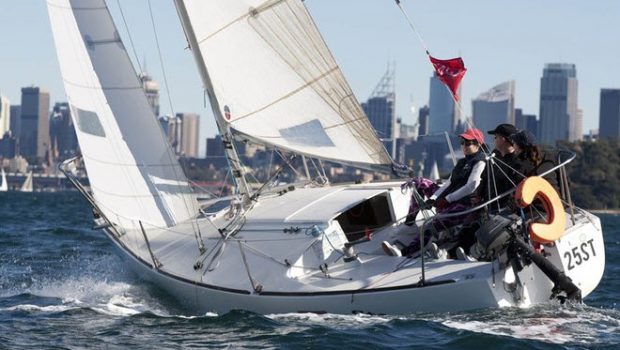Growth: Why Have a JAM Section?
Published on April 25th, 2018
by James E. Schrager, St. Joseph River Yacht Club
This is a test. Select the best answer for why your Club has a Jib and Main (JAM) section:
1) For beginners only
2) For shorthanded skippers
3) For cruising boats
4) For skippers with older racing/cruising boats
5) None of the above
6) All of the above.
If you selected #1, you picked the reason why most JAM fleets started many years ago. JAM provided a section where beginners got to try all the unique activities that make racing so much fun, like starts, mark roundings, sailing in all kinds of weather, navigation, and of course, a round of beer at the Club post-race. But the times they have been a-changing, and today, the best JAM programs are much more than just for beginners.
Answer #2 is another good reason to sail in JAM, because a seasoned crew hasn’t yet been developed, or the skipper decides to sail shorthanded. These aren’t bad reasons to be in JAM, but there are other better reasons. So like answer #1, this isn’t correct for our quiz.
Giving cruising boat sailors the very special experiences racers enjoy is an excellent reason for a JAM section. Cruising is so much different than racing that even experienced skippers have plenty to learn by getting out on the race course frequently. Although a good answer, like the first two, the best JAM sections usually have more than just pure cruising boats. So #3 is also not correct.
Older sailboats are essentially different than newer boats. This divide has been evident since the advent of production fiberglass boats over fifty years ago. That difference remains wide today, not only because of variances in the predicted performance of older versus newer boats in different wind and water conditions, but also because of budget requirements and crew expertise.
For example, a brand new 29-foot J/88 will cost about $150K to bring to the starting line, while an older used C&C 33 can be racing for $20K. The C&C with its simple masthead rig is a breeze to operate in JAM (pun intended) with very few sail changes required. But the J/88, beyond the budget issues, needs a well-trained crew to hoist and douse those giant asymmetrical spinnakers in all kinds of weather. Both types of boats require knowledgeable skippers and talented crew to win in JAM for the older C&C 33 or in Spinnaker for the state-of-the-art J/88.
This reason #4 provides an important motivation for your Club to have a JAM section. Competitive JAM racing opens up a whole new arena for skippers who don’t have a newer boat, a bigger budget, or access to a wide selection of expert crew trained through years of competition.
We can now eliminate #5, as “None of the above” makes no sense given the good choices already noted. This brings us to the right answer, “All of the above.” But wait, how can beginners race against boats with experienced skippers and crew? How can short-handed boats keep up? Will cruising boats find a home is a section with all this racing going on?
The answers are a resounding yes, if you follow just a few rules. The first is that any boat is welcome in JAM as long as it is 25-30 years old, and is not built with a carbon fiber mast, bow sprit, or exotic hull laminates. If it is a true cruising boat, it can be of any vintage. You can have as many or few crew as you like onboard, no restrictions. Single handers are welcome as long as they sail an older racing/cruising or true cruising boat.
These boat requirements follow from the analysis prepared by Bruce Bingman, Chair of the US PHRF Committee. He finds the fairest racing takes place when similar-type boats race against each other. In thinking about rating spreads, he suggests placing similar boats in the same section, even if the rating spread is wide. Bruce’s in-depth three part series on how best to configure PHRF racing sections reviewed the data behind his conclusions.
So what about beginners? We welcome new racers in our JAM section as they are some of our most consistent participants. Of course, they don’t expect to win and most don’t, but we’ve discovered that’s fine.
How can they have fun in a section with better skippers as well? Our newer racers actually aren’t offended by having good sailors in JAM. After all, how else does anyone learn? The beginners watch the seasoned hands at the start, take cues from them on the course, and observe how they stay out of trouble. The same is true of skippers with cruising boats and those sailing shorthanded.
In fact, with a few good racers at the top of your JAM fleet you’ll likely attract others with older boats bringing in more competition. Last year in St. Joseph (Michigan) we had two older spinnaker boats drop into JAM and win races. Both skippers were skilled and transferred into JAM to be able to race, rather than being stuck with an old boat in our Spinnaker section filled with newer, lighter, faster boats.
Although left in the dust by the hot hardware in our Spinnaker section, older Spinnaker section boats find it tougher in JAM than they thought but still possible to do well. A few years ago, a very fast recent Mac-winner and prior SJRYC Spinnaker Boat of the Year dropped into JAM for the second half of the summer. They sailed their older boat fast and absolutely knew what they were doing. But they didn’t dominate, ending up in second place for the series, having won just a few races.
Nobody’s mad when this happens. The top skippers in JAM like the competition as it gives them a chance to up their game. The beginners and cruisers enjoy a bigger group of boats with more good sailors to learn from.
By developing a section with older racer-cruisers along with pure cruising boats, PHRF ratings work quite well, even with fairly wide section spreads. Last year, one of the smallest boats in our JAM section won our Summer Series soundly beating all the bigger “faster” boats. JAM Boat of the Year for 2017 was decided between three top boats and hinged on the outcome of a single race. If the winner had lost one place at any point in the season to either of the runner-ups, we’d have had a different BotY in JAM in 2017. It can’t get much closer than that.
JAM Boat of the Year finishes in St. Joe weren’t close just in 2017. They have been amazingly close for the last seven years, with plenty of competition and in many cases tighter finishes than in our heavily weaponized Spinnaker section. We believe the more competition the better, so we all get the chance to become better sailors.
The outcome we’ve seen has been both more boats racing and better competition. We think those goals are the right ones and speak directly to the reasons why a growing, vibrant, competitive JAM section exists in our race program.
By setting up your JAM section this way you’ll make a home for all those skippers on a budget looking for the chance to race their older boats competitively against other similar craft. Without this approach, most of our current JAM fleet would be forced to sit on the sidelines. Develop a JAM section like this at your Club and you might be surprised how your fleet will expand, bringing better competition as well.
Jim Schrager, 2018 St. Joseph River Yacht Club Fleet Captain, has raced offshore sailboats for over thirty years. For the past decade he’s raced with his kids and friends out of St. Joseph, Michigan.
Source: April 2018 e-newsmagazine of Lake Michigan Sail Racing Federation.









 We’ll keep your information safe.
We’ll keep your information safe.